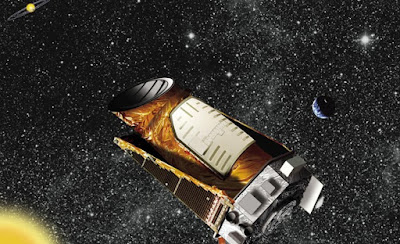 |
| Red-giant spotter: artist’s impression of the Kepler space telescope in Earth orbit. (Courtesy: NASA) |
Topics: Astronomy, Astrophysics, Solar Physics
Some red-giant stars are rotating much faster than previously thought, according to a study led by Patrick Gaulme at Germany’s Max Planck Institute for Solar System Research. Using NASA’s Kepler space telescope, the astronomers found that about 8% of the red giants they observed are rotating fast enough to display starspots. The team reckons that the elderly stars acquire their rapid rotation by following one of three distinct routes in their evolution.
In main sequence stars like the Sun, the complex interplay that occurs between stellar rotation and the motions of plasma creates incredibly lively magnetic fields. When this magnetic activity is particularly strong, upwelling plumes of plasma in a star’s convective outer layers can be blocked, producing dark patches on its surface. To an observer on Earth, these starspots cause a periodic variation in the star’s brightness as it rotates, bringing the spots in and out of our field of view.
Until recently, starspots were not thought to be present on red giant surfaces. Since these older stars expand rapidly as they move out of the main sequence, while maintaining their angular momentum, previous theories had predicted that they must rotate more slowly than main sequence stars. Slower rotation should reduce magnetic activity, preventing starspots from forming.
Starspot study sheds light on why some red giants spin faster than others, Sam Jarman, Physics World